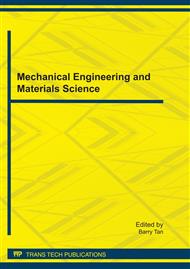[1]
Krämer, M. Petra, Weber, Optical Immunosensor and ELISA for the Analysis of Pyrethroids and DDT in Environmental Samples, Rational Environmental Management of Agrochemicals. September 21, 2007, pp.186-202.
DOI: 10.1021/bk-2007-0966.ch012
Google Scholar
[2]
Hufnagel, A. Huebner, C. Gülch, K. Güse, C. Abell, F. Hollfelder, An integrated cell culture lab on a chip: modular microdevices for cultivation of mammalian cells and delivery into microfluidic microdroplets, Lab. Chip. 9, 2009, pp.1576-1582.
DOI: 10.1039/b821695a
Google Scholar
[3]
D. G. Anderson, S. Levenberg, R. Langer, Nanoliter-scale synthesis ofarrayed biomaterials and application to human embryonic stem cells, Nat Biotechnology, 22(7), 2004, p.863–866.
DOI: 10.1038/nbt981
Google Scholar
[4]
P. J. Hung, P. Sabounchi, R. Lin, L. P. Lee, Continuous perfusion microfluidic cell culture array for high-throughput cell-based assays, Biotechnol. Bioeng. , 89, 2005, pp.1-8.
DOI: 10.1002/bit.20289
Google Scholar
[5]
Z. H. Wang, M. C. Kim, M. Marquez and T. Thorsen, High-density microfluidic arrays for cell cytotoxicity analysis, Lab Chip, vol. 7, 2007, p.740–745.
DOI: 10.1039/b618734j
Google Scholar
[6]
Bo Ma, Guohao Zhang, Jianhua Qin and Bingcheng Lin, Characterization of drug metabolites and cytotoxicity assay simultaneously using an integrated microfluidic device, Lab Chip, vol. 9, 2009, p.232–238.
DOI: 10.1039/b809117j
Google Scholar
[7]
M. E. Nuttall, A. J. Patton, D. L. Olivera, D. P. Nadeau, Human trabecular bone cells are able to express both osteoblastic and adipocytic phenotype: implications for osteopenic disorders, J. Bone Miner. Res., 13, 1998, pp.371-382.
DOI: 10.1359/jbmr.1998.13.3.371
Google Scholar
[8]
A. X. Zhang, W. H. Yu, B. F. Ma, Proteomic identification of differently expressed proteins responsible for osteoblast differentiation from human mesenchymal stem cells, Mol. Cell. Biochem., 304, 2007, p.167–179.
DOI: 10.1007/s11010-007-9497-3
Google Scholar
[9]
B. Johnstone, T. M. Hering, A. I. Caplan, V. M. Goldberg, J. U. Yoo, In vitro chondrogenesis of bone marrow-derived mesenchymal progenitor cells, Exp. Cell Res., 238, 1998, pp.265-272.
DOI: 10.1006/excr.1997.3858
Google Scholar
[10]
H. Hachisuka, Y. Mochizuki, Y. Yasunaga, Flow cytometric discrimination of mesenchymal progenitor cells from bone marrow-adherent cell populations using CD34/44/45(-) and Sca-1(+) markers., vol. 12, 2007, pp.161-169.
DOI: 10.1007/s00776-006-1098-6
Google Scholar
[11]
F. P. Barry, R. E. Boynton, S. Haynesworth, J. M. Murphy, J. Zaia, The monoclonal antibody SH-2, raised against human mesenchymal stem cells, recognizes an epitope on endoglin (CD105), Biochem Biophys Res Commun, 265, 1999, pp.134-139.
DOI: 10.1006/bbrc.1999.1620
Google Scholar
[12]
F. Barry, R. Boynton, M. Murphy, J. Zaia, The SH-3 and SH-4 antibodies recognize distinct epitopes on CD73 from human mesenchymal stem cells, Biochemical and Biophysical Research Communications, 289, 2001, pp.519-524.
DOI: 10.1006/bbrc.2001.6013
Google Scholar
[13]
X. M. Zhao, Y. N. Xia, G. M. Whitesides, Soft lithographic methods for nano-fabrication, J. Mater. Chem., 7, 1997, pp.1069-1074.
DOI: 10.1039/a700145b
Google Scholar
[14]
S. R. Liu, Q. S, Pu, J. J. Lu, Electric field-decoupled electroosmotic pump for microfluidic devices, J. Chromatogr. A, 1013, 2003, p.57–64.
DOI: 10.1016/s0021-9673(03)00941-5
Google Scholar


